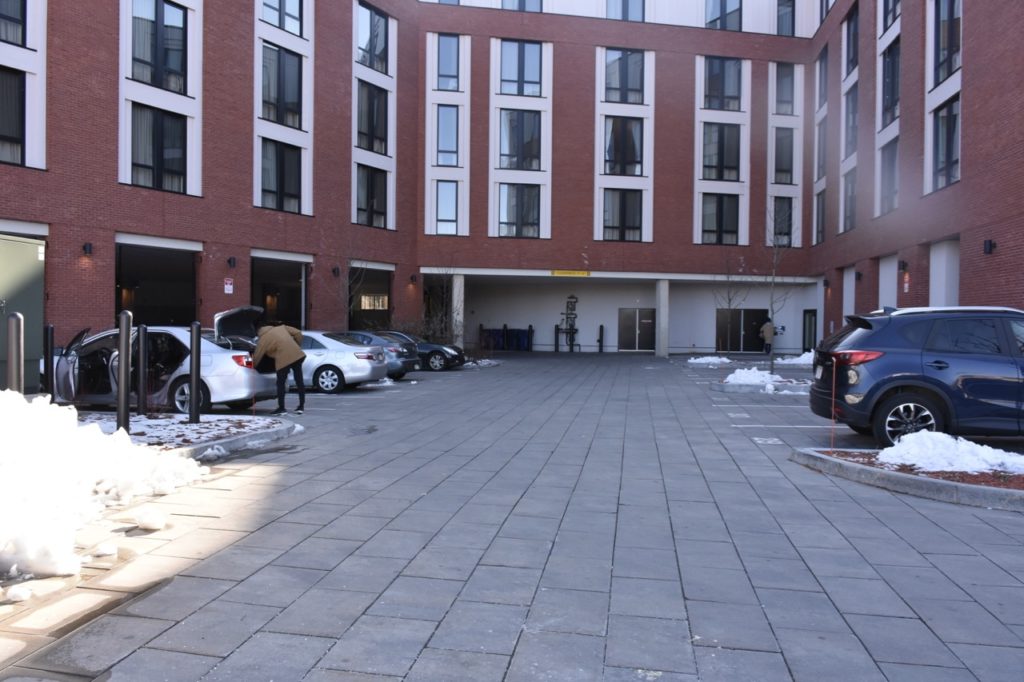Opinion: A Tale Of Two Cities. Housing Inaccessibility In The Town Of Amherst

Resident's Parking Lot, One East Pleasant Street. Photo: Art Keene

With housing comes a sense of safety and community, as a form of sanctuary from the outside world. Extending beyond poviding shelter, a stable home allows individuals to make long-term choices, shielding them from the compounding consequences of housing insecurity. As someone from a previously homeless family, I recall the perpetual feeling of dislocation that came with hotel and shelter living. It clouded my mind and rewrote my priorities as the search for food and housing overshadowed family conversations and day-to-day survival took hold. My family’s search for housing tells a story of classism and inaccessibility; while we couch-surfed and lived in hotels for shelter, landlords and property owners denied our housing applications and reinforced the trauma of our economic reality. Effective housing policy in this historic moment requires solutions that ensure it is a universal right, prioritizing the production of public housing and holding the landlord community accountable for discrimination in the private market.
In Amherst, the presence of the university and the motive to create student housing has priced out moderate and low income town residents. Student competition for housing underlies the tension between town residents and the university, juxtaposed with already high housing costs in the state. At the University of Massachusetts Amherst, 46 percent of students come from the top 20 percent income bracket, while six percent come from the bottom 20 percent. At Amherst College, economic diversity is even more striking; 60 percent of students come from the top 20 percent income bracket and 51 percent come from the top 10 percent. On the other hand, 4.7 percent of students come from the bottom 20 percent. This consolidation of privilege not only reflects systemic inaccessibility to higher education, it also has consequences for housing availability and cost in the community. Expensive housing developments provide a home for affluent students who attend the local universities, thereby attracting economic benefits for local businesses and the community as a whole. However, the result limits housing development and affordability for low income residents and students, exacerbating residential inequity.
Proposed federal solutions to this problem do not address the root causes of the housing crisis, serving to normalize its commodification. Joe Biden, the Democratic nominee for President, has detailed a housing plan that centers a universal housing voucher program. It mentions the development of a “national strategy for making housing a right for all,” but the focus on vouchers and emergency rental assistance – while beneficial – fails to question the underlying foundations of the country’s housing system.
Biden’s proposed plan legitimizes the status quo and at most is a form of harm reduction. The universal voucher program will expand Section 8 Voucher provision, thus continuing the reliance on the private rental system as a means to providing housing for those in-need. This pact comes at taxpayer and human cost, however. A study in Milwaukee, Wisconsin, which followed the effects of the federal Housing Choice Voucher Program (HCVP) found that “vouchered households are charged between $51 and $68 more in monthly rent than unassisted renters in comparable units and neighborhoods.” In doing so, this constituted a $3.8 million overpayment – a disparity that could have funded 620 families on housing assistance each year. Housing vouchers are tied to the fair market rent ceiling of a metropolitan area, and thus tenants are often overcharged when the market rent falls below this price level, as noted in the study. Beyond overpayment, exclusionary zoning policies often restrict the development of affordable housing units and concentrate poverty.
Additionally, this program does not consider the ways that landlords can reject voucher-holders from housing units, as they may be informed by classist, preconceived notions of those on federal assistance. Even with a universal voucher system, renters are subject to the whims of private landlords – and landlords may be able to reject a voucher holder through non-response. There is ingrained classism present in housing applications which manifests in CORI and credit checks, that in combination with landlord non-response, systematically excludes low income and working class populations from housing.
Biden has proposed the creation of a “Homeowner and Renters Bill of Rights,” which would include provisions that prohibit source of income discrimination if the recipient recieves federal benefits. In combination with a voucher program expansion, this bill of rights will ensure renters will be more able to access housing. This does not prohibit the inclusion of criminal record and credit checks in housing applications, however, and is limited in the scope of housing assistance discrimination. While an increase in voucher accessibility and protection from source of income discrimination will provide housing to more low-income populations, this proposal fails to guarantee long-lasting housing stability and the extent of landlord or real estate discrimination – that which can be done through merely ignoring an email.
As a previous caseworker at a local nonprofit, I helped homeless clients with the housing search process and housing applications. In this role, I saw the general lack of affordable housing in the area. Additionally, housing applications, even in public-private partnerships, were intrusive and the presence of a CORI or credit check often led to an application denial. Many local landlords or those advertising sublets refused housing to clients the moment they were revealed to be voucher-holders or low-income. Some individuals and agencies simply did not respond to email when a voucher-holder was requesting information on available housing. Even in a town such as Amherst, already limited affordable housing access for low-income and working class groups is compounded by implicit classism that prioritizes affluent students.
In the short-term, state and federal action that increases the production of affordable housing, expands emergency rental assistance, and protects those seeking private housing from landlord discrimination are necessary first steps to ensuring equity in housing access. Looking forward, legislators must phase out voucher provision with free public housing to guarantee such as a basic universal right and to end homelessness.
Timothy Scalona is a graduate student in the UMass Amherst School of Public Policy.

So you think vouchers aren’t the answer. What is?